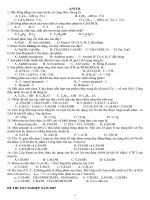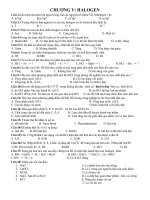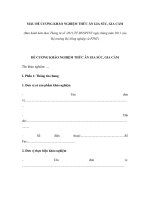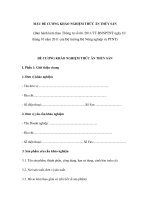Đề cương trắc nghiệm Hành Vi Tổ Chức (Organizational Behavior) CHƯƠNG 8
Bạn đang xem bản rút gọn của tài liệu. Xem và tải ngay bản đầy đủ của tài liệu tại đây (44.49 KB, 15 trang )
Chapter 8: Communicating in
Organizational Settings
8-1. Electronic mail tends to:
a. reduce the likelihood of information overload.
b. reduce the risk of sending emotionally charged messages to
other people.
c. increase the likelihood that the receiver will correctly interpret
the emotional meaning of the sender's message.
d. transmit messages faster than traditional written media.
e. do all of the above
The question was not answered. The correct answer
is "d". (Coaching responses are only available for answered
questions)
8-2. The psychological, social, and structural barriers that distort
and obscure the sender's intended message is called
a. medium
b. encoding
c. MBWA
d. noise
e. decoding
The question was not answered. The correct answer
is "d". (Coaching responses are only available for answered
questions)
8-3. When Microsoft employees use Microspeak to
communicate their ideas, they are mainly relying on:
a. Jargon.
b. Ambiguity.
c. Emotions.
d. information overload.
e. Filtering.
The question was not answered. The correct answer
is "a". (Coaching responses are only available for answered
questions)
8-4. Reading summaries of large reports rather than the entire
document:
a. Increases information processing capacity
b. increases information load
c. reduces information processing capacity
d. reduces information load
e. does both 'a' and 'd'
The question was not answered. The correct answer
is "d". (Coaching responses are only available for answered
questions)
8-5. A job's information load can be reduced by:
a. learning to read faster.
b. buffering.
c. scanning documents more efficiently.
d. adding information to the job.
e. time management.
The question was not answered. The correct answer
is "b". (Coaching responses are only available for answered
questions)
8-6. Sending an emotionally charged electronic mail message is
referred to:
a. emotional contagion.
b. flaming.
c. jargon.
d. emoticons.
e. spamming.
The question was not answered. The correct answer
is "b". (Coaching responses are only available for answered
questions)
8-7. Which of these is(are) considered problem(s) with e-mail?
a. E-mail contributes to information overload.
b. E-mail lacks the warmth of human interaction.
c. It is difficult to interpret the emotional meaning behind e-mail
messages.
d. E-mail seems to reduce our politeness and respect for others.
e. All of these.
The question was not answered. The correct answer
is "e". (Coaching responses are only available for answered
questions)
8-8. Which of these suggest that as the web of computer
networks expands, distance will shrink and eventually become
irrelevant?
a. Media richness
b. Emotional contagion
c. The inoculation effect
d. The law of telecosm
e. MBWA
The question was not answered. The correct answer
is "d". (Coaching responses are only available for answered
questions)
8-9. The automatic and subconscious tendency to mimic and
synchronize our nonverbal behaviours with other people is
called:
a. emotional dissonance
b. the inoculation effect.
c. emotional contagion.
d. empathy.
e. emotional labour.
The question was not answered. The correct answer
is "c". (Coaching responses are only available for answered
questions)
8-10. Which of these is the richest communication medium?
a. Video conference
b. Face-to-face
c. E-mail
d. Telephone
e. Newsletters
The question was not answered. The correct answer
is "b". (Coaching responses are only available for answered
questions)
8-11. Which of these communication channels is the "leanest" in
the hierarchy of media richness?
a. Telephone
b. E-mail
c. Face-to-face
d. Financial statements
e. Video conference
The question was not answered. The correct answer
is "d". (Coaching responses are only available for answered
questions)
8-12. A workspace where desks and offices are shared rather
than assigned to specific people is called:
a. MBWA
b. Hotelling
c. A grapevine
d. Filtering
e. The law of telecosm.
The question was not answered. The correct answer
is "b". (Coaching responses are only available for answered
questions)
8-13. The grapevine typically transmits information through:
a. Newsletters.
b. the cluster chain pattern.
c. Video conferencing.
d. Emotional contagion.
e. Buffering.
The question was not answered. The correct answer
is "b". (Coaching responses are only available for answered
questions)
8-14. To preserve a sense of harmony, people in the Japanese
place much value in:
a. Written communication.
b. Verbal communication.
c. Silence.
d. Deceit.
e. MBWA.
The question was not answered. The correct answer
is "c". (Coaching responses are only available for answered
questions)
8-15. Sensing, evaluating, and responding represent:
a. The three main components of listening.
b. The main sources of filtering in organizational hierarchies.
c. The three ways that people engage in emotional contagion.
d. The main ways that men and women differ in their
communication styles.
e. The three stages of flaming.
The question was not answered. The correct answer
is "a". (Coaching responses are only available for answered
questions)
8-16. Which of these is a persuasive communication strategy of
warning listeners that others will try to influence them in the
future and that they should be wary about the opponents'
arguments?
a. MBWA
b. Emotional contagion
c. Flaming
d. Inoculation effect
e. Active listening
The question was not answered. The correct answer
is "d". (Coaching responses are only available for answered
questions)
TRUE or FALSE
8-1. In the communication process model, decoding the message
refers to selecting the appropriate medium and sending your
ideas through that medium.
True / False
The question was not answered. The correct answer
is "False". (Coaching responses are only available for answered
questions)
8-2. Filtering is most common where the organization rewards
employees who communicate mainly positive information and
among employees with strong career mobility aspirations.
True / False
The question was not answered. The correct answer
is "True". (Coaching responses are only available for answered
questions)
8-3. One of the golden rules of effective communication is to
avoid jargon at all costs.
True / False
The question was not answered. The correct answer
is "False". (Coaching responses are only available for answered
questions)
8-4. Information overload occurs the job's information load is
less than the person's information processing capacity.
True / False
The question was not answered. The correct answer
is "False". (Coaching responses are only available for answered
questions)
8-5. E-mail tends to reduce our politeness and respect for others.
True / False
The question was not answered. The correct answer
is "True". (Coaching responses are only available for answered
questions)
8-6. Flaming occurs when we use a communication medium
offering more media richness than is required for the situation.
True / False
The question was not answered. The correct answer
is "False". (Coaching responses are only available for answered
questions)
8-7. In terms of media richness, newsletters have the highest
data carrying capacity.
True / False
The question was not answered. The correct answer
is "False". (Coaching responses are only available for answered
questions)
8-8. Hotelling occurs when employees are temporarily assigned
a desk or cubicle rather than a permanent space when they visit
the office.
True / False
The question was not answered. The correct answer
is "True". (Coaching responses are only available for answered
questions)
8-9. One problem with MBWA is it takes away the opportunity
for executives to explain corporate decisions at a more personal
level.
True / False
The question was not answered. The correct answer
is "False". (Coaching responses are only available for answered
questions)
8-10. The grapevine is more active where employees have
similar backgrounds and are able to communicate easily with
each other.
True / False
The question was not answered. The correct answer
is "True". (Coaching responses are only available for answered
questions)
8-11. Language is the most obvious cross-cultural barrier.
True / False
The question was not answered. The correct answer
is "True". (Coaching responses are only available for answered
questions)
8-12. When having a conversation with someone from Japan,
you are expected to show enthusiasm by starting to talk while
the other person is still speaking.
True / False
The question was not answered. The correct answer
is "False". (Coaching responses are only available for answered
questions)
8-13. The three components of listening are sensing, evaluating,
and responding.
True / False
The question was not answered. The correct answer
is "True". (Coaching responses are only available for answered
questions)









